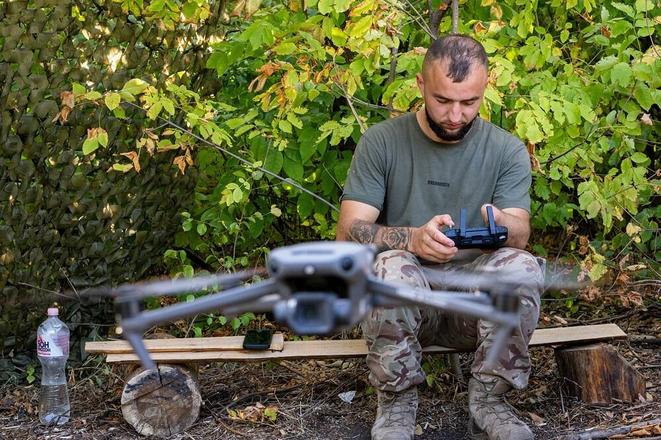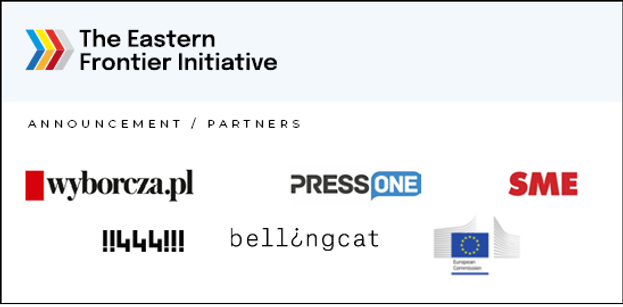A trench on the Ukrainian-Russian front is a relatively safe place. Soldiers can take cover, crawl into a hole, and there is a chance a medic is somewhere nearby.
"The most critical moment is the rotation, when a soldier has to sprint from the rotation point to the trench with full gear. That’s when he’s completely exposed," says Bratislava-based entrepreneur and documentary filmmaker Marcel Rebro, who co-founded the organisation Nezlomní with journalist Jana Čavojská. Together, they organise public fundraisers in Slovakia to buy drones for Ukraine.
"If a soldier is wounded during the day, there’s no chance he’ll be evacuated before sunset. He has to hold on until nightfall," Rebro explains from his office, where he is preparing another batch of drones.
A wounded soldier is bait – Russians literally wait for an evacuation team to come for him, so they can strike. In such situations, drones can be lifesaving. They can deliver first-aid kits, tourniquets, bottles of water, or radios.
"Often, the most important thing for a soldier is simply knowing that he hasn’t been forgotten – that someone out there is aware of him. If he survives until sunset, he can hope that, under cover of darkness, an evacuation team will come for him," he says.
The drones purchased with donated funds are commercially available online, costing hundreds or sometimes thousands of euros. However, Ukrainian soldiers modify them – improvising all sorts of ‘MacGyver-style’ upgrades – to serve new purposes: dropping grenades or bombs, guiding troops, or transmitting radio signals.
Ironically, Slovakia’s Prime Minister Robert Fico may have unintentionally helped boost Nezlomní’s fundraising efforts for Ukraine.
What Putin’s visit accelerated
Two days before Christmas Eve, reports surfaced in the media that Prime Minister Fico had visited Moscow and held talks with Vladimir Putin. At the time, Rebro and Čavojská were convinced that, so close to Christmas, people were unlikely to contribute significantly to their fundraiser for drones for Ukraine, having already spent their money on gifts.
However, Fico’s visit changed that. Within two days, the fundraiser for "Ukrainian" drones had received an additional €10,000. Then, at the end of January, when Nezlomní published a blog urging Robert Fico to accompany him to Ukraine to meet Mamuka Mamulashvili, the commander of the Georgian Legion, donations surged again – raising €4,000 in just one morning.
The fundraiser supports the purchase of medical supplies, such as tourniquets to stop bleeding, portable power sources, and, most importantly, drones – primarily reconnaissance models equipped with wide-angle or infrared cameras.
Drones like the Mavic 3T come with cameras, remote controls, and the ability to hover in place, navigate terrain obstacles, and take off or land autonomously.
Some of their features are immediately useful; others, however, could prove deadly for drone operators in war.
"When you switch on a drone like this, it instantly starts broadcasting its location – so both the operator and the drone know where they are," explains Rebro. This is highly dangerous for operators in combat, as drones transmit on publicly accessible frequencies that Russian forces can track. This would effectively guide enemy fire directly to the operator. The first step, therefore, is to reinstall the firmware. The manufacturer’s software is replaced by a Ukrainian version, ensuring the drone no longer broadcasts its position. Instead, the operator controls it from the trenches solely by watching the live feed from its camera.
Additionally, the drones are fitted with more powerful antennas or protective "jackets," 3D-printed by Ukrainians, which make them more resistant to harsh weather conditions.
The simplest use of camera-equipped drones is reconnaissance and fire correction – helping to conserve ammunition. "A mortar operator typically needs about four rounds to ‘zero in’ on a target," Rebro and Čavojská recount from their experiences in Ukraine. Even the most precise targeting does not guarantee a hit on the first attempt. However, with the help of a drone camera and a map, the exact coordinates can be determined, allowing the operator to strike the target with the first shell.
They drop bombs too
Drones designed for reconnaissance also serve as relays, transmitting radio signals. These drones fly at higher altitudes, where, in addition to gathering intelligence, they act as intermediaries between an operator in a trench and a low-flying kamikaze drone, which would otherwise lose radio contact without the relay.
A reconnaissance drone functions as the apex of an imaginary triangle between the operator and the kamikaze drone, while the relay drone provides terrain awareness and strengthens the signal.
"If a Mavic is used as a combat drone, it’s deployed for dropping bombs. Soldiers attach a simple device to it that can grip and release a bomb roughly the size of a hand grenade," explains Rebro.
However, hand grenades are unnecessarily heavy and not very effective, he says. Ukrainians are 3D-printing small bombs, filling plastic casings with explosives and adding ball bearings or tiny plastic shards with sharp edges. Commercially available drones can drop half-kilo "mini-bombs" that are more effective than grenades.
Larger, winged drones with wingspans of up to three metres – developed in Ukraine – can also be used for laying mines. A drone with a range of around 200 kilometres follows a pre-programmed route and can drop a mine precisely on a selected target, such as a location where Russian forces previously parked a transport vehicle.
These drones are guided by GPS but carry a "shield" on their fuselage that prevents interference with the GPS receiver from the ground. To maintain its connection, the drone flies without sharp tilts, avoiding exposure to jamming. Made from plastic and composite materials, the aircraft has a minimal radar signature.
"The point of drone-laid mines isn’t just to cause damage. A crucial effect is to confuse the enemy. If they discover mines deep behind their own lines, they assume saboteurs are operating there. This forces them to deploy personnel who would otherwise be used at the front," say members of the unit known as Angry Birds.
Not all drones rely on GPS or an operator’s control. Some can read terrain using onboard cameras and navigate by recognising distinct landmarks. Others, originally developed for agricultural use – such as crop-spraying drones – have payload capacities of 30 to 50 kilograms, making them capable of carrying and deploying anti-tank mines.
Supply and rescue
"If a soldier is wounded in the morning or during the day, the chances of evacuation are zero," says Čavojská. Russian forces also use reconnaissance and attack drones that would quickly detect and kill rescuing soldiers or medics. A wounded soldier must survive on the spot until sunset – only then does he have a chance that someone will come for him.
A trench is a relatively safe place on the front line. It provides cover, and a medic can even be present there. The most critical moment is during troop rotations, when soldiers must sprint from the rotation point to the trench with full gear. This is why rotations are only carried out at night.
On the battlefield, a drone can deliver a bottle of water, a small first-aid kit, painkillers, or a radio to a wounded soldier. Commercially available camera drones can be adapted for precisely this purpose.
When a drone drops a radio to an injured soldier, a medic in the trench can give him instructions on how to treat himself in a way that maximises his chances of survival.
Surrender and follow me
Drones in Ukraine are used not only for reconnaissance and strikes but also for traditional methods of psychological warfare, such as dropping leaflets on enemy soldiers – or even communicating with those looking to surrender.
"On Christmas Eve, near Hulyaipole, Russian forces attacked a Ukrainian position. The Ukrainians managed to take cover and then used drones to eliminate seven Russian soldiers. The Russians don’t usually retrieve their fallen, but in this case, their commander wanted them back. A Russian drone flew in and dropped a radio into the Ukrainian position. After an inspection by explosives specialists, the Ukrainians heard the Russians on the other end, requesting to collect their dead," recounts Rebro. The soldier who witnessed the incident and told him the story didn’t live to see another day – the Russians killed him the next morning.
Similarly, drones equipped with speakers drop leaflets instructing Russian soldiers on how to surrender, before issuing further directions and guiding them towards Ukrainian lines. "A Russian will only surrender when he’s alone. If there are two of them, he’s afraid the other will betray or even kill him."
Slovak-made drones are also being used to retrieve downed drones from the battlefield using a mechanical arm. These salvaged drones can be used for spare parts, and some can even be fully repaired.
The Eastern Frontier Initiative
This article was written in the framework of The Eastern Frontier Initiative (TEFI) project. TEFI is a collaboration of independent publishers from Central and Eastern Europe, to foster common thinking and cooperation on European security issues in the region. The project aims to promote knowledge sharing in the European press and contribute to a more resilient European democracy.
Members of the consortium are 444 (Hungary), Gazeta Wyborcza (Poland), SME (Slovakia), PressOne (Romania), and Bellingcat (The Netherlands).The TEFI project is co-financed by the European Union.
Views and opinions expressed are however those of the author(s) only and do not necessarily reflect those of the European Union or the European Education and Culture Executive Agency (EACEA). Neither the European Union nor EACEA can be held responsible for them.

 Ukrainian soldiers modify drones to serve new purposes. (source: Nezlomní - Jana Čavojská)
Ukrainian soldiers modify drones to serve new purposes. (source: Nezlomní - Jana Čavojská)
 (source: TEFI)
(source: TEFI)